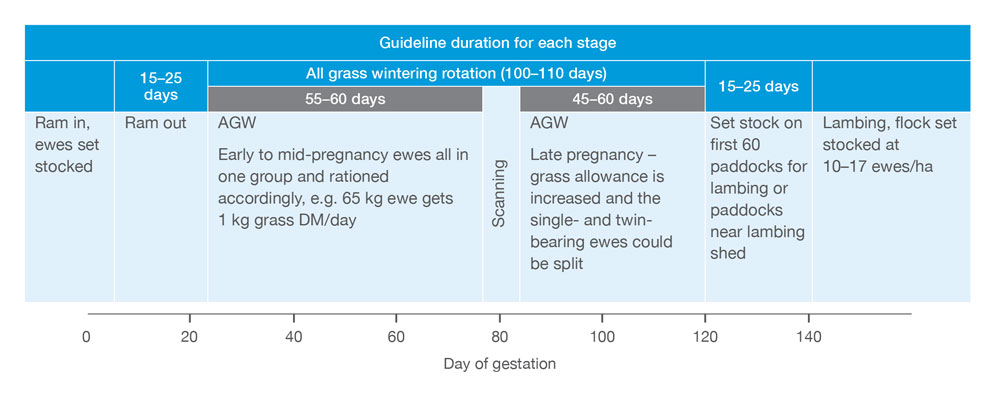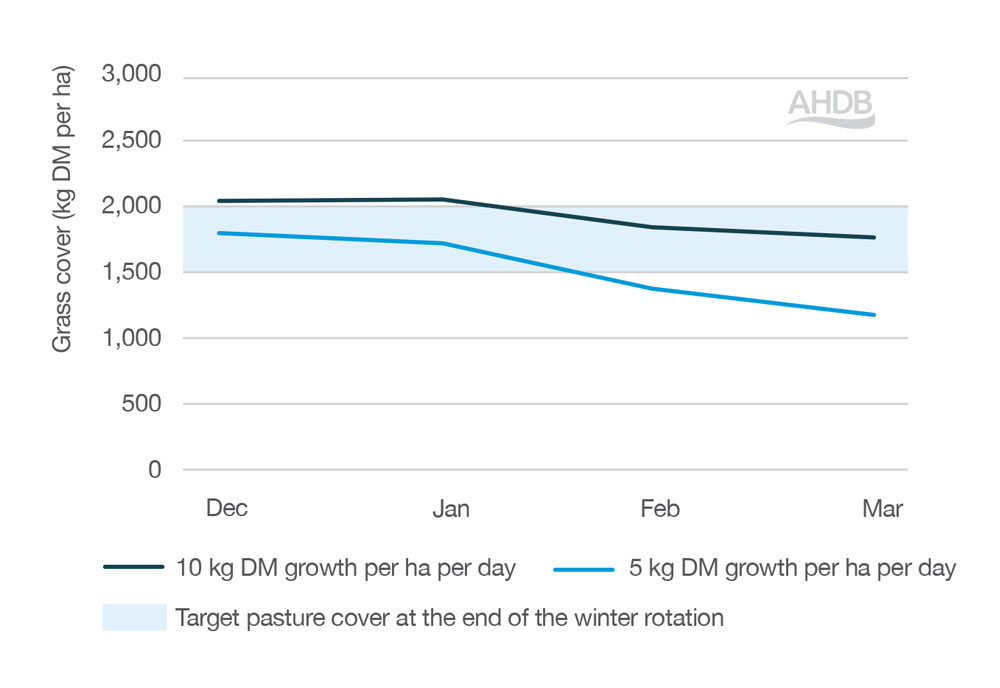- Home
- Knowledge library
- Grass allocation and feed budgeting for wintering at grass
Grass allocation and feed budgeting for wintering at grass
Knowing your target grass covers can help you plan ahead and maximise grass utilisation. See our tips and advice on how to achieve this.
Back to: Deferred grazing/all-grass wintering
Why is accurate grass allocation important?
Assessing the available feed in the fields in kg dry matter (DM) per ha allows grass to be rationed according to stock requirements. Without rationing, there is risk of over or under-estimating what grazing provides. Underestimation represents an inefficient use of a cheap feed, and overestimating will result in loss of body condition, compromising animal health and performance.
As with other crops, deferred grazing requires a flexible approach. Aim for a dense sward with a high proportion of leaf to live material to maximise quality. Permanent pasture or long-term leys are suited due to their dense swards, which can minimise soil damage. Grass growth and quality can vary greatly from November onwards, with an average of 11 MJ/kg DM ME expected.
Target grass covers
Turn animals out onto covers of around 3,250 kg DM/ha and graze down to 1,500 kg DM/ha. Farm grass cover should average at 2,000–2,500 kg DM/ha before the winter system commences.
The residual is the amount of grass (or cover) that is left following grazing. If this is too high, it represents a wasted feed opportunity and may compromise tiller density and feed quality in the spring.
If managed appropriately, outwintering on strip grazed grass fields can be achieved without substantially damaging pasture or reducing the subsequent years of grass production.
Estimate grass supply by using a calibrated sward stick that converts sward height to kg DM/ha, or use a plate meter. Care should be taken when using a plate meter on very high swards (above 3,500 kg DM) or where there are a lot of stems, as the accuracy of the readings will be reduced. For more information, see Grass measuring methods for rotational grazing.
Converting compressed grass height to dry matter (DM) quantity per ha
|
Season |
Feed available (kg DM/ha) estimations according to compressed grass height |
||||
|
1 cm |
2 cm |
3 cm |
4 cm |
5 cm |
|
|
Winter |
830 |
990 |
1,140 |
1,300 |
1,460 |
|
Spring |
680 |
1,050 |
1,340 |
1,580 |
1,780 |
|
Late spring |
800 |
1,120 |
1,400 |
1,650 |
1,880 |
|
Summer |
930 |
1,190 |
1,450 |
1,710 |
1,980 |
|
Autumn |
810 |
1,050 |
1,290 |
1,540 |
1,780 |
Note: These figures provide reference values, but will vary according to weather, location, grass variety and age of pasture
High rainfall in spring generally leads to low DM content, while low rainfall in summer creates higher DM content. It also accounts for seasonal variation in the amount of seed heads, green material, dead material and clover content.
Example allocation for ewes
Guideline deferred grazing allocation for ewes

Note: Allows for some feed rejection and is based on high feed quality for a flock scanning at approximately 150%. Worked example for 65 kg ewes on daily shifts. Demand in mid pregnancy is: 65 x 0.015 (1.5%) = about 1 kg DM/ewe/day. This allows for 15% wastage, as DM intake will be 0.85 kg/day. Note, on 2–3 days shifts, waste will be 15–30% and therefore allocate more. Demand in late pregnancy is: 65 x 0.02 (2%) = 1.3 kg DM feed/ewe/day.
General intake requirements for different classes of sheep
|
Stock |
Intake requirements (% of body weight) |
|
Dry ewes Mid pregnancy ewes |
1.5 |
|
Late pregnancy ewes |
2.0 |
|
Mid to late lactation ewes |
2.5 |
|
Early lactation ewes |
3 or more |
|
Growing lambs |
4.0 |
Note: Allows for some feed rejection and is based on high feed quality for a flock scanning at approximately 150%.
Daily feed requirements from scanning to lambing adjusted for pasture quality and scanning results
|
Feed quality |
Single lamb |
Twins |
Triplets |
|
kg DM/ewe/day for a 65 kg ewe (% of body weight) |
|||
|
Low |
1.2 (1.8%) |
1.5 (2.2%) |
1.6 (2.5%) |
|
High |
1.1 (1.6%) |
1.3 (2.0%) |
1.5 (2.2%) |
Note: Calculated using SRUC Feedbyte rationing software
Use these figures as a guide and increase allowances to 3% of liveweight per day in wet and windy weather to allow for extra demands and feed wastage. If grass growth has been poor and ewes are losing too much condition, feed up to 0.45 kg of concentrates/day gradually and house if necessary.
Preparing a feed budget for deferred grazing
Once the livestock nutrition demand and grass DM supply have been estimated, a feed budget can be prepared and paddocks set up. A feed budget will help you to gain a better understanding of how grass supply will meet demand.
An example feed budget is shown below, or use the AHDB grass and supplementation budget planner or Feed budget and rotation plan for cattle.
Feed budget for 950 mature ewes assuming 10 kg DM/ha/day grass growth, high feed quality and 200% scanning (initial cover 2,000 kg DM/ha)
|
|
Dec |
Jan |
Feb |
|
Grazing area (ha) |
110 |
110 |
110 |
|
Grazing days |
31 |
31 |
28 |
|
Net growth rate (kg DM/ha/day) |
10 |
10 |
10 |
|
Animal intakes |
Dec |
Jan |
Feb |
|
Number of ewes |
950 |
950 |
950 |
|
Weight (kg) |
65 |
67 |
69 |
|
Intake (% of body weight) |
1.5 |
1.5 |
2.7 |
|
Daily intake (kg DM) |
1.0 |
1.0 |
1.9 |
|
Total daily requirement (kg DM) |
950 |
950 |
1,770 |
|
Total monthly animal intake (kg DM) |
29,450 |
29,450 |
49,556 |
|
Animal intake per ha (kg DM/ha/day) |
8.6 |
8.6 |
16 |
|
Difference between growth and intake (kg DM/ha/day) |
1.4 |
1.4 |
-6.0 |
|
Average farm cover (kg DM/ha) |
2,043 |
2,086 |
1,919 |
Note: The feed budget accounts for weight increase as pregnancy progresses. Animal intake per ha per day (daily intake/area) is calculated to determine the difference between intake and growth per ha, which will affect cover (difference x grazing days plus starting cover).
Comparing two winter grass growth scenarios with the spring cover target of between 1,500 and 2,000 kg DM per ha

An important part of budgeting is making provision for adverse weather events. Silage or hay can be useful for snow or frost, and allowance should be calculated based on animal demand, assuming 10–30% wastage. Silage should be analysed for precise figures on DM percentage and energy content. An average of 10.5 MJ/kg DM ME is required.
Snow cover for five days in mid–January would result in the following: 6.3 kg fresh weight/head/day silage allowance (40% DM) x 950 ewes = 6 tonnes silage FW requirement per day. Over the five-day period, this could use up to 30 tonnes FW of silage or 50 bales (at 600 kg each).
Moving stock from good grazing pastures onto a ‘sacrifice field’ in wet weather that is planned for a reseed will reduce poaching damage in the most productive fields. High stocking rates in wet weather increases the likelihood of compaction. Some farmers have found moving livestock every 12 hours on well-established reseeds in wet weather limits pasture damage.
Useful links
Using brassicas for Better Returns manual
If you would like to order a hard copy of Using brassicas for Better Returns please contact publications@ahdb.org.uk or call 0247 799 0069.
Topics:
Sectors:
Tags:

